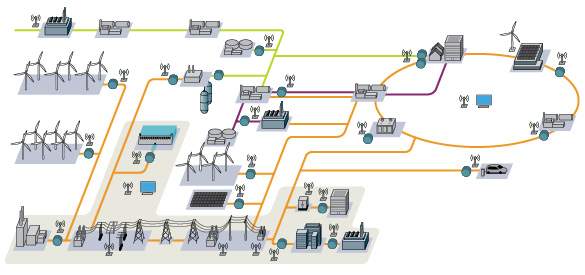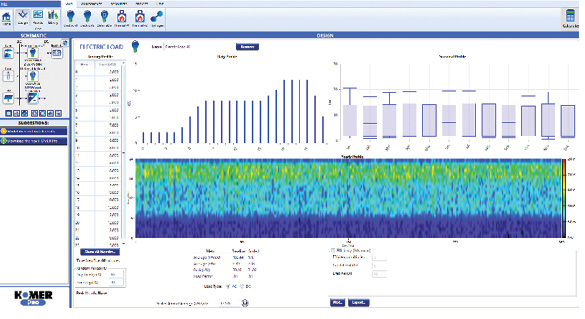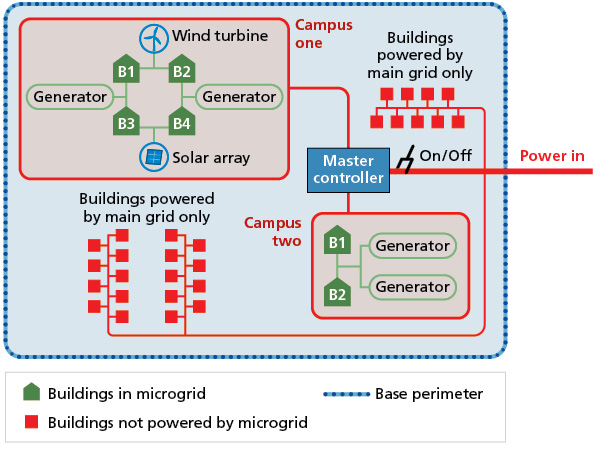

February 8, 2018
Increased interest in microgrids coupled with better and more robust digital tools to operate and maintain assets is leading to innovation in the microgrid design space.

Diagram showing how utilities are seeing more DERs on the grid, including solar, wind, and energy storage. The circle above represents a microgrid. Credit: Bentley Systems/Siemens.
If the energy industry learned anything in 2017, it was that energy systems are highly vulnerable to damage from hurricanes, wild fires and other natural disasters and work should be done to make the world’s electric grids much more resilient.
Enter the microgrid, a concept that has been around for decades but is only now beginning to be recognized for the full benefits that it can offer. Because they are attached to the larger grid, but have the ability to function as a small grid, microgrids can be put in place around critical infrastructure like hospitals, schools, police stations, and shelters in any given village, city or town across the world. This way, if the greater grid experiences an outage, grid operators can first restore power to the microgrid, bringing critical power to people when they need it. Once the microgrid is functional, crews can work to restore power to the greater grid. In addition to the resiliency aspect of microgrids, they also carry with them the benefit of allowing for greater integration of renewable energy. “If you want to have renewables at a high penetration, it’s just easier to do that on a microgrid,” said Peter Lilienthal, of HOMER Energy, maker of microgrid modeling software. Lilienthal added, “big utilities will tell you they are doing great at 20-30 percent [renewable energy integration] but on a microgrid you can do 80 percent easily.”
HOMER, the micro- power optimization model at the National Renewable Energy Lab (NREL), helps you design off-grid and grid-connected systems. You can use HOMER to perform analyses to explore a wide range of design questions:
HOMER’s optimization and sensitivity analysis capabilities help you answer these difficult questions. The microgrid design process has typically three phases. The first phase is when all that exists is an idea. HOMER Energy’s software has been used by more than 150,000 people in 193 countries in the 25 years it has been in existence. HOMER software was created at the NREL and then was in part privatized as HOMER Energy, in 2009. Major users include World Bank, General Electric, Caterpillar, ABB, and Tesla.

HOMER Pro electric load profile screen. Credit: HOMER Energy.
“What HOMER Pro is good for is understanding the tradeoffs,” explained Lilienthal, adding, “the more renewables or storage you have, the less you need your backup generator…what drives the tradeoffs is the economics.” The software combines the technical simulation and optimization with economics so that users can evaluate those tradeoffs. Once you have figured out your design, you begin selecting components for your microgrid, which is another place that the software shines. “We call that detail design,” and “That’s where you narrow it down and you are choosing between specific components,” said Lilienthal. HOMER Pro is technology and vendor agnostic. The software helps users select components. Vendors are able to pay to get priority placement in the component list, however the software is not biased in favor of them.
“What we hear over and over again is the amount of time that [DER] salespeople spend educating prospective customers,” he said, adding that many times these customers turn out not to be prospective customers at all because a component they might think they want in a microgrid, won’t actually provide the service they are looking for. At the second stage, users will need to bring in different software companies “to start looking at other things like power flow on the wires, how much wiring do you need, what kind of protection devices do you need, etc. The third and final stage is the construction stage, when the design is complete, engineering drawings have been developed and a firm has been hired to do the construction. As far as performing ongoing operations and maintenance (O&M) of the finished microgrid, software is not there yet, although the system does factor upkeep into its calculations. Input a whole maintenance schedule predicts after a certain number of operating hours tune-up or an overhaul are required.
While HOMER’s sweet spot is microgrids between 100 kW and 10 MW, Bentley Systems’ OpenUtilities application, now integrated with Siemens Power Systems Simulation Suite (PSS), works for any size of network, according to Ton De Vries, Business Development Director at Bentley. However, De Vries acknowledges that if the project is a small system, its best to outsource. “If it is really small, maybe you are better off outsourcing to an engineering firm but if you do this frequently or have a mixture of microgrids and you want to continue to regularly expand the grid and modify or replace equipment in the grid, the tool is equipped for doing both,” he explained.
Utilities use software like OpenUtilities, to create a model of their grid infrastructure. The technology can be used to create a microgrid within an existing grid, and offers decision support tools to make the process of adding DERs to an existing grid more efficient. If a DER, such as a solar array or storage system, will not exceed the utility’s pre-determined boundaries, then the project moves forward. But, “if it goes over then it must go to the planning or engineering department to see what kind of modification is needed,” said De Vries. Siemens’ knowledge and experience in energy system planning and simulation brings the quality of power to OpenUtilities. Thereby providing designers and engineers with the capability of geographically and — from a cost perspective — optimizing their design as well as from a power quality perspective.”

A basic representation of campus microgrids on an Air Force installation. Each campus has separate energy resources and both campuses are controlled by a master controller to island them from the main grid and direct power within or between them. Credit: U.S. Air Force illustration by Jeff Pendleton.
The applications together allow utilities to not only model their entire grid, with all of the DERs included, but also allows them to perform simulations and see how grid-edge power will integrate into the whole network.
“The influence of distributed energy resources on the grid edge requires utility companies to be a little cautious of the components and the power flow at the grid edge,” said De Vries. Finally, as the microgrid moves through the design process and is ultimately built, what results is the physical microgrid, built using OpenUtilities and a digital twin, which engineers can optimize by running simulations to determine, for example, how they could increase the power output of the microgrid, optimize the maintenance schedule, or optimize the performance of the system.
De Vries acknowledges that while utilities are starting to embrace digital tools, there is still a ways to go. “It’s an evolution driven by requirements,” he said. Today, utilities have a lot to manage and while some are embracing digital tools, oftentimes the result of those tools is a static model, “so while you are digitizing part of the process, you are not creating a digital representation of the asset you are managing and maintaining,” said De Vries.
Bentley is trying to make the process easier.
“We are starting to offer these capabilities fully hosted in the cloud, which means that internal IT work and cost are minimized, giving utilities the option to deploy these systems pretty quickly and also get quick return on investment,” he said. Renewable Energy World By Jennifer Runyon Chief Editor Homer at NREL.
Murphy International
Development, LLC
65 Redding Road
Georgetown, CT
06829-0807 USA
phone: (203) 544-8303
info@murphyintldev.com
Murphy International Development services independent power producers and developers of renewable and conventional plants including; solar, wind, Biomass, hydroelectric, geothermal, CHP, cogeneration and alternative fuels projects.
